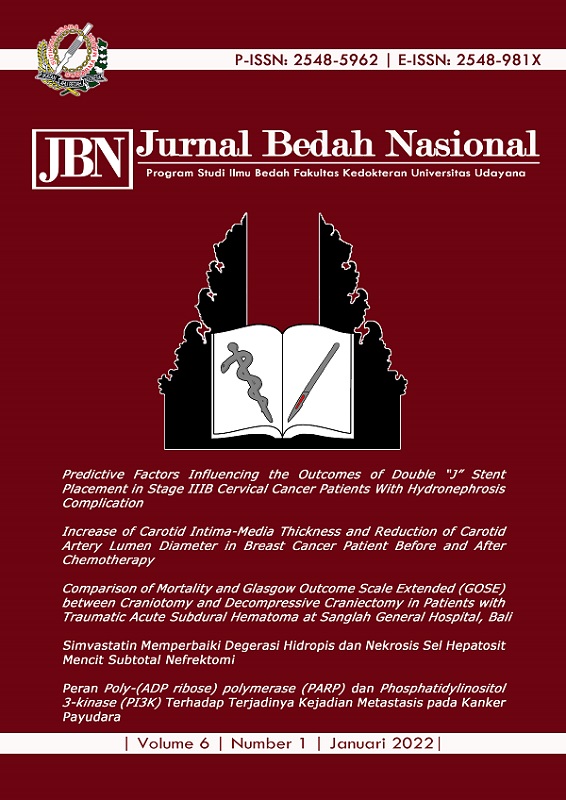Increase of Carotid Intima-Media Thickness and Reduction of Carotid Artery Lumen Diameter in Breast Cancer Patient Before and After Chemotherapy
Abstract
Background: Increasing number of cancer survivor motivates clinical practitioner to focus on chronic effect of chemotherapy agent, especially those with vascular toxicity effect, which may attenuate the incidence of thrombosis and atherogenesis. Ultrasonography examination on carotid intima media thickness (C-IMT) provides acurate result in evaluating atherosclerotic. The purposes of this research are to find out any structural changes of carotid artery, especially atheroclerosis changes in breast cancer patient after chemoteraphy. Methods: Analytic cross sectional study using a pre post test group design in breast cancer patients. Eligible subjects undergo carotid ultrasonography examination prior to chemoteraphy and after they had completed the 3 cycles of chemoteraphy for the second exam. The examination was perfomed with the same USG machine, high frequency linier transducer (>7mHz) in B-mode under the auspecies of two reputable radiologist consultant. Results: Total patients are 26, mean of age (year) is 47.15 ± 8.11. Most dominant histopathology finding is invasive carcinoma nonspecific type, in 24 patients (92.4%) and the disease stage is in stadium III in 14 patients (53.9%). Mean C-IMT (mm) prior chemotherapy is 0.51 ± 0.06 and after chemotherapy is 0.58 ± 0.05, there is an increase of 0.07 ± 0.06 (p<0.0001). Carotid artery lumen diameter (mm) before chemotherapy is 4.05 ± 0.66 and after chemotherapy is 3.90 ± 0.73, so there is a decrease of 0.16 ± 0.40 (p =0.057). Conclusion: There is a statistically significant increase in intima media thickness of carotid wall of breast cancer patients after chemotherapy, consisted with chemoteraphy induced atherosclerosis.
Downloads
References
2. Schonberg MA, Marcantonio ER, Ngo L, et al. Causes of Death and Relative survival of Older Woman after Cancer Diagnosis. J Clin Oncol. 2011;29:1570-7.
3. Wang XM, Walitt B, Saligan L, et al. Chemobrain: A Critical review and causal hypothesis of Link between cytokines and epigenetic reprogramming associated with chemotherapy. Cytokine. 2015;72:86-96.
4. Ahles TA, Root JC, Ryan EL. Cancer-and Cancer Treatment-Associated Cognitive Change: An update on the State of the Science. J Clin Oncol. 2012;30:3675-86.
5. Cicconetti P, Riolo N, Priami C, et al. Risk Factor For Cognitive Impairement. Refenti Prog Med. 2004;95:535-45.
6. Chen WH, Jin W, Lyu PY, et al. Carotid Atherosclerosis and Cognitive Impairment in Nonstroke Patients. Chin Med J. 2017;130:2375‑9.
7. Cameron AC, Touyz RM, Lang NN. Vascular Complication of Cancer Chemotherapy. Can J Cardiol. 2016;32:852-62.
8. Scappaticci FA, Skillings JR, Holden SN, et al. Arterial thromboembolic Event in Patient with metastatic carcinoma treated with Chemotherapy and Bevacizumab. J Natl Cancer Inst. 2007;99:1232-9.
9. Nezu T, Hosomi N, Aoki S, et al. Carotid Intima-Media Thickness for Atherosclerosis. J Atheroscler Thromb. 2016;23:18-31.
10. Thamasebpour HR, Buckley AR, Cooperberg PL, et al. Sonographic Examination of The Carotid Arteries. RadioGraphics. 2005;25:1561-75.
11. Dallal GE. The Little Handbook of Statistical Practice. [serial online] 2012 [cited 2018 October 28]. Available from: http://www.jerrydallal.com/ LHSP/sizenotes.htm.
12. Saxena Y, Saxena V, Mittal M, et al. Age-Wise association of Carotid Intima Media Thickness in Ischemic stroke. Ann Neurosci. 2017;24:4-11.
13. Karima UQ, Wahyono TYM. Faktor-faktor yang berhubungan dengan kejadian kanker payudara wanita di Rumah Sakit Umum Pusat Nasional dr. Cipto Mangunkusuma Jakarta tahun 2013. [tesis]. Jakarta: Universitas Indonesia; 2013.
14. Hartaningsih NMD, Sudarsa IW. Kanker Payudara Pada Wanita Usia Muda di Bagian Bedah Onkologi Rumah Sakit Umum Pusat Sanglah Denpasar tahun 2002-2012. E-Jurnal Medika Udayana. 2014;3:1-14.
15. Primadanti SJ, Setiawan IGB. Prevalensi kanker payudara subtipe triple negative pada wanita usia muda di Bali periode Januari 2014-Oktober 2016. E-Jurnal Medika. 2018;7:87-90.
16. Kusumadjayanti N, Badudu DF, Hernowo BS. Characteristics of patients with estrogenreceptor (ER)-negative, progesterone receptor(PR)-negative, and HER2-negative invasive breast cancer in Dr. Hasan Sadikin General Hospital, Bandung, Indonesia from 2010 to 2011. Althea Medical Journal. 2015;2:391-4.
17. Min SS, Wierzbicki A. Radiotherapy, Chemoteraphy and atherosclerosis. Curr Opin Cardiol. 2017;32:441-7.
18. Cai F, Luis MAF, Lin X, et al. Anthracycline-induced cardiotoxicity in the chemotherapy treatment of breast cancer: preventive strategies and treatment. Mol Clin Oncol. 2019;11:15-23.
19. Daher IN, Yeh ETH. Vascular complication of selected cancer therapies. Nat Clin Pract Cardiovasc Med. 2008;5:797-805.
20. Herrmann J, Yang EH, Iliescu C, et al. Vascular Toxicities of cancer therapies. Circulation. 2016;133:1272-89.
21. Boulos MN, Gardin JM, Malik S, et al. Carotid Plaque Characterization, Stenosis, and Intima-Media Thickness According to Age and Gender in a large Registry Cohort. Am J Cardiol. 2016;117:1185-91.

This work is licensed under a Creative Commons Attribution 4.0 International License.
Program Studi Ilmu Bedah Fakultas Kedokteran Universitas Udayana. 
This work is licensed under a Creative Commons Attribution 4.0 International License.






